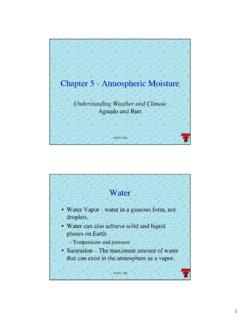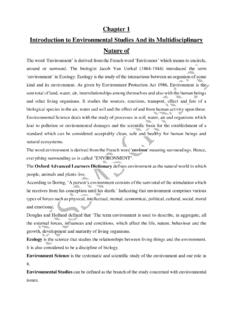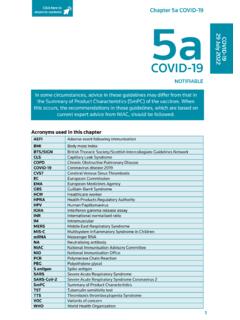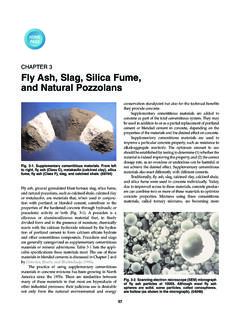Transcription of Environmental Issues - NCERT
1 Human population size has grown enormously over thelast hundred years. This means increase in demand forfood, water, home, electricity, roads, automobiles andnumerous other commodities. These demands are exertingtremendous pressure on our natural resources, and arealso contributing to pollution of air, water and soil. Theneed of the hour is to check the degradation and depletionof our precious natural resources and pollution withouthalting the process of is any undesirable change in physical,chemical or biological characteristics of air, land, water orsoil. Agents that bring about such an undesirable changeare called as pollutants. In order to control environmentalpollution, the Government of India has passed theEnvironment (Protection) Act, 1986 to protectand improve the quality of our environment (air, waterand soil).
2 AIR POLLUTION AND ITS CONTROLWe are dependent on air for our respiratory needs. Airpollutants cause injury to all living organisms. Theyreduce growth and yield of crops and cause prematuredeath of plants. Air pollutants also deleteriously affect therespiratory system of humans and of animals. HarmfulCHAPTER 16 Environmental Pollution and Pollution and andtheir effect andGlobal Ozone Depletion in by ImproperResource Utilisation 22271 Environmental Issues effects depend on the concentration of pollutants, duration of exposureand the of thermal power plants, smelters and other industriesrelease particulate and gaseous air pollutants together with harmlessgases, such as nitrogen, oxygen, etc.
3 These pollutants must be separated/filtered out before releasing the harmless gases into the Electrostatic precipitatorThere are several ways of removing particulate matter; the most widelyused of which is the electrostatic precipitator (Figure ), which canremove over 99 per cent particulate matter present in the exhaust from athermal power plant. It has electrode wires that are maintained at severalthousand volts, which produce a corona that releases electrons. Theseelectrons attach to dust particles giving them a net negative charge. Thecollecting plates are grounded and attract the charged dust velocity of air between the plates must be low enough to allow thedust to fall. A scrubber (Figure ) can remove gases like sulphurdioxide.
4 In a scrubber, the exhaust is passed through a spray of water orlime. Recently we have realised the dangers of particulate matter that arevery very small and are not removed by these precipitators. According toCentral Pollution Control Board (CPCB), particulate size micrometersor less in diameter (PM ) are responsible for causing the greatest harmto human health. These fine particulates can be inhaled deep into thelungs and can cause breathing and respiratory symptoms, irritation,inflammations and damage to the lungs and premature 22272 BIOLOGYA utomobiles are a major cause for atmospheric pollution atleast inthe metro cities. As the number of vehicles increase on the streets, thisproblem is now shifting to the other cities too.
5 Proper maintenance ofautomobiles along with use of lead-free petrol or diesel can reduce thepollutants they emit. Catalytic converters, having expensive metals namelyplatinum-palladium and rhodium as the catalysts, are fitted intoautomobiles for reducing emission of poisonous gases. As the exhaustpasses through the catalytic converter, unburnt hydrocarbons areconverted into carbon dioxide and water, and carbon monoxide and nitricoxide are changed to carbon dioxide and nitrogen gas, respectively. Motorvehicles equipped with catalytic converter should use unleaded petrolbecause lead in the petrol inactivates the India, the Air (Prevention and Control of Pollution) Act cameinto force in 1981, but was amended in 1987 to include noise as an airpollutant.
6 Noise is undesired high level of sound. We have got used toassociating loud sounds with pleasure and entertainment not realisingthat noise causes psychological and physiological disorders in bigger the city, the bigger the function, the greater the noise!! Abrief exposure to extremely high sound level, 150 dB or more generatedby take off of a jet plane or rocket, may damage ear drums thuspermanently impairing hearing ability. Even chronic exposure to arelatively lower noise level of cities may permanently damage hearingabilities of humans. Noise also causes sleeplessness, increased heartbeat, altered breathing pattern, thus considerably stressing the many dangerous effects of noise pollution can youidentify the unnecessary sources of noise pollution around you whichcan be reduced immediately without any financial loss to anybody?
7 Reduction of noise in our industries can be affected by use of sound-absorbent materials or by muffling noise. Stringent following of laws laiddown in relation to noise like delimitation of horn-free zones aroundhospitals and schools, permissible sound-levels of crackers and of loud-speakers, timings after which loudspeakers cannot be played, etc., needto be enforced to protect ourselves from noise Vehicular Air Pollution: A CaseStudy of DelhiWith its very large population of vehicular traffic, Delhi leads the coun-try in its levels of air-pollution it has more cars than the states ofGujarat and West Bengal put together. In the 1990s, Delhi rankedfourth among the 41 most polluted cities of the world.
8 Air pollutionproblems in Delhi became so serious that a public interest litigation(PIL) was filed in the Supreme Court of India. After being censured verystrongly by the Supreme Court, under its directives, the governmentwas asked to take, within a specified time period, appropriate meas-ures, including switching over the entire fleet of public transport, ,buses, from diesel to compressed natural gas (CNG). All the buses ofDelhi were converted to run on CNG by the end of 2002. You may askthe question as to why CNG is better than diesel. The answer is that2021 22273 Environmental ISSUESCNG burns most efficiently, unlike petrol or diesel, in the automobilesand very little of it is left unburnt.
9 Moreover, CNG is cheaper than petrolor diesel, cannot be siphoned off by thieves and adulterated like petrolor diesel. The main problem with switching over to CNG is the difficultyof laying down pipelines to deliver CNG through distribution points/pumps and ensuring uninterrupted supply. Simultaneously parallelsteps taken in Delhi for reducing vehicular pollution include phasingout of old vehicles, use of unleaded petrol, use of low-sulphur petroland diesel, use of catalytic converters in vehicles, application of stringentpollution-level norms for vehicles, Government of India through a new auto fuel policy has laidout a roadmap to cut down vehicular pollution in Indian cities.
10 Morestringent norms for fuels means steadily reducing the sulphur andaromatic content in petrol and diesel fuels. Euro III norms, for example,stipulate that sulphur be controlled at 350 parts-per-million (ppm) indiesel and 150 ppm in petrol. Aromatic hydrocarbons are to be containedat 42 per cent of the concerned fuel. The goal, according to the roadmap,is to reduce sulphur to 50 ppm in petrol and diesel and bring down thelevel to 35 per cent. Corresponding to the fuel, vehicle engines will alsoneed to be Emission Standards (Bharat Stage II which is equivalent toEuro-II norms) are no more applicable in any of the cities of of the latest Mass Emission Standards in India are providedbelow (Table )Type of VehiclesNormsCities of Implementation4 WheelersBharat Stage IVThroughout the countrysince April 20173 WheelersBharat Stage IVThroughout the countrysince 1st April 20172 WheelersBharat Stage IVThroughout the countrysince April 2017 Table : Table Showing the Mass Emission Standards in IndiaThanks to the efforts made, the air quality of Delhi has significantlyimproved.
















